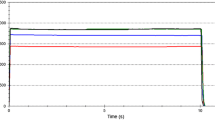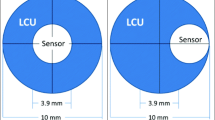Abstract
To determine the influence of light curing units (LCUs) and material viscosity on the degree of conversion (DC) of bulk-fill (BF) resin-based composites (RBCs) placed in deep cavity preparations. Four LCUs were tested: Valo cordless, Bluephase-G2, Poly wireless and Radii-cal. Light irradiance was determined at 0 mm and 6 mm distance to the reading sensor. The following RBCs were considered: Filtek BF, Filtek BF Flow, Opus BF, Opus BF Flow, Tetric N-Ceram BF and Surefil SDR Flow. Sirius-Z was used with the incremental technique. DC (n = 3) was evaluated by spectroscopy both at top and bottom regions of deep preparations with 6 mm depth. The data were submitted to ANOVA and Tukey’s test (α = 0.05). Pearson’s correlation (95%) was used to verify the relation between the LCUs and the curing potential of RBCs. The DC at 6 mm depth was reduced when Opus BF, Opus BF Flow and Tetric N-Ceram BF were activated with Radii-cal. There was a positive correlation between the LCU irradiance and the bottom/top conversion ratios. The materials’ viscosities did not affect the curing potential. Bulk-fill composites did not present higher curing potential than the conventional composite used with the incremental technique; the most important aspect of the LCU was the irradiance ratio; and the materials’ viscosity did not affect the curing potential as a function of depth. Radii-cal negatively impacted the degree of conversion at 6 mm depth for most bulk-fill resin composites. Depending on the brand, bulk-fill composites may present reduced curing potential due to the light source when placed in deep cavities. Dentists should avoid LCU with acrylic tips to photoactivate bulk-fill resin-based composites.


Similar content being viewed by others
References
Tardem C, Albuquerque EG, Lopes LS, Marins SS, Calazans FS, Poubel LA, Barcelos R, Barceleiro MO. Clinical time and postoperative sensitivity after use of bulk-fill (syringe and capsule) vs. incremental filling composites: a randomized clinical trial. Braz Oral Res. 2019;16:e089. https://doi.org/10.1590/1807-3107bor-2019.vol33.0089.
Palin WM, Leprince JG, Hadis MA. Shining a light on high volume photocurable materials. Dent Mater. 2018;34:695–710.
Van Ende N, De Munck J, Lise DP, Van Meerbeek B. Bulk-fill composites: a review of the current literature. J Adhes Dent. 2017;19:95–109.
Fronza BM, Rueggeberg FA, Braga RR, Mogilevych B, Soares LE, Martin AA, Ambrosano G, Gianini M. Monomer conversion, microhardness, internal marginal adaptation, and shrinkage stress of bulk-fill resin composites. Dent Mater. 2015;31:1542–51.
Al Sunbul H, Silikas N, Watts DC. Polymerization shrinkage kinetics and shrinkage-stress in dental resin-composites. Dent Mater. 2016;32:998–1006.
Alshali RZ, Salim NA, Sung R, Satterthwaite JD, Silikas N. Qualitative and quantitative characterization of monomers of uncured bulk-fill and conventional resin-composites using liquid chromatography/mass spectrometry. Dent Mater. 2015;31:711–20.
Reis AF, Vestphal M, Amaral RCD, Rodrigues JA, Roulet JF, Roscoe MG. Efficiency of polymerization of bulk-fill composite resins: a systematic review. Braz Oral Res. 2017;31(Suppl 1):e59.
Shimokawa C, Turbino ML, Giannini M, Braga RR, Price RB. Effect of curing light and exposure time on the polymerization of bulk-fill resin-based composites in molar teeth. Oper Dent. 2020;45:E141–55.
Rueggeberg FA, Giannini M, Arrais CAG, Price RBT. Light curing in dentistry and clinical implications: a literature review. Braz Oral Res. 2017;31(Suppl):e61.
Shimokawa CAK, Turbino ML, Giannini M, Braga RR, Price RB. Effect of light curing units on the polymerization of bulk fill resin-based composites. Dent Mater. 2018;34:1211–21.
Alrahlah A, Silikas N, Watts DC. Post-cure depth of cure of bulk fill dental resin-composites. Dent Mater. 2014;30:149–54.
Garcia D, Yaman P, Dennison J, Neiva GF. Polymerization shrinkage and depth of cure of bulk-fill flowable composite resins. Oper Dent. 2014;39:441–8.
Tarle Z, Attin T, Marovic D, Andermatt L, Ristic M, Tauböck TT. Influence of irradiation time on subsurface degree of conversion and microhardness of high-viscosity bulk-fill resin composites. Clin Oral Investig. 2015;19:831–40.
Algamaiah H, Silikas N, Watts DC. Conversion kinetics of rapid photo-polymerized resin composites. Dent Mater. 2020;36:1266–74.
Kaisarly D, El Gezawi M, Keßler A, Rösch P, Kunzelmann KH. Shrinkage vectors in flowable bulk-fill and conventional composites: bulk versus incremental application. Clin Oral Investig. 2020. https://doi.org/10.1007/s00784-020-03412-3.
Sahadi BO, Price RB, André CB, Sebold M, Bermejo GN, Palma-Dibb RG, Faraoni JJ, Soares CJ, Giannini M. Multiple-peak and single-peak dental curing lights comparison on the wear resistance of bulk-fill composites. Braz Oral Res. 2018;17:e122.
Albuquerque PP, Bertolo ML, Cavalcante LM, Pfeifer C, Schneider LF. Degree of conversion, depth of cure, and color stability of experimental dental composite formulated with camphorquinone and phenanthrenequinone photoinitiators. J Esthet Restor Dent. 2015;27:S49-57.
Tabatabaei MH, Nahavandi AM, Khorshidi S, Hashemikamangar SS. Fluorescence and opalescence of two dental composite resins. Eur J Dent. 2019;13:527–34.
Lima RBW, Troconis CCM, Moreno MBP, Murillo-Gómez F, De Goes MF. Depth of cure of bulk fill resin composites: A systematic review. J Esthet Restor Dent. 2018;30:492–501.
Ilie N, Hickel R. Investigations on a methacrylate-based flowable composite based on the SDRTM technology. Dent Mater. 2011;27:348–55.
Fonseca AS, Labruna Moreira AD, de Albuquerque PP, de Menezes LR, Pfeifer CS, Schneider LF. Effect of monomer type on the CC degree of conversion, water sorption and solubility, and color stability of model dental composites. Dent Mater. 2017;33:394–401.
Price RB, Ferracane JL, Hickel R, Sullivan B. The light-curing unit: an essential piece of dental equipment. Int Dent J. 2020;70:407–17.
Alshali RZ, Silikas N, Satterthwaite JD. Degree of conversion of bulk-fill compared to conventional resin-composites at two time intervals. Dent Mater. 2013;29:e213–7.
Leprince JG, Palin WM, Vanacker J, Sabbagh J, Devaux J, Leloup G. Physico-mechanical characteristics of commercially available bulk-fill composites. J Dent. 2014;42:993–1000.
Tauböck TT, Jäger F, Attin T. Polymerization shrinkage and shrinkage force kinetics of high- and low-viscosity dimethacrylate- and ormocer-based bulk-fill resin composites. Odontolog. 2019;107:103–10.
Funding
Rodrigo Antonio Modena received MSc scholarship from CAPES/Brazil (Finance code 001). Luis Felipe Schneider receives the Young Scientist of Rio de Janeiro State Scholarship from FAPERJ/Rio de Janeiro/Brazil (E-26/202.735/2018).
Author information
Authors and Affiliations
Corresponding author
Ethics declarations
Conflict of interest
Rodrigo Antonio Modena declares that he has no conflict of interest. Larissa Maria Cavalcante declares that she has no conflict of interest. Mário Alexandre Coelho Sinhoreti declares that he has no conflict of interest. William Palin declares that he has no conflict of interest. Luis Felipe Schneider declares that has received consultant honorarium from DFL Company.
Ethical approval
This article does not contain any studies with human participants or animals performed by any of the authors.
Informed consent
For this type of study, formal consent is not required.
Additional information
Publisher's Note
Springer Nature remains neutral with regard to jurisdictional claims in published maps and institutional affiliations.
Rights and permissions
About this article
Cite this article
Modena, R.A., Sinhoreti, M.A.C., Palin, W. et al. Light and viscosity effects on the curing potential of bulk-fill composites placed in deep cavities. Odontology 109, 874–883 (2021). https://doi.org/10.1007/s10266-021-00614-3
Received:
Accepted:
Published:
Issue Date:
DOI: https://doi.org/10.1007/s10266-021-00614-3




